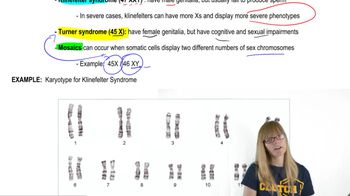Table of contents
- 1. Introduction to Genetics51m
- 2. Mendel's Laws of Inheritance3h 37m
- 3. Extensions to Mendelian Inheritance2h 41m
- 4. Genetic Mapping and Linkage2h 28m
- 5. Genetics of Bacteria and Viruses1h 21m
- 6. Chromosomal Variation1h 48m
- 7. DNA and Chromosome Structure56m
- 8. DNA Replication1h 10m
- 9. Mitosis and Meiosis1h 34m
- 10. Transcription1h 0m
- 11. Translation58m
- 12. Gene Regulation in Prokaryotes1h 19m
- 13. Gene Regulation in Eukaryotes44m
- 14. Genetic Control of Development44m
- 15. Genomes and Genomics1h 50m
- 16. Transposable Elements47m
- 17. Mutation, Repair, and Recombination1h 6m
- 18. Molecular Genetic Tools19m
- 19. Cancer Genetics29m
- 20. Quantitative Genetics1h 26m
- 21. Population Genetics50m
- 22. Evolutionary Genetics29m
3. Extensions to Mendelian Inheritance
Sex Chromosome
Problem 26
Textbook Question
Textbook QuestionIn humans, SRY is located near a pseudoautosomal region (PAR) of the Y chromosome, a region of homology between the X and Y chromosomes that allows them to synapse during meiosis in males and is a region of crossover between the chromosomes. The diagram below shows SRY in relation to the pseudoautosomal region.

About 1 in every 25,000 newborn infants is born with sex reversal; the infant is either an apparent male but with two X chromosomes or an apparent female but with an X and a Y chromosome. Explain the origin of sex reversal in human males and females involving the SRY gene. (Hint: See Experimental Insight 3.1 for a clue about the mutational mechanism.)
 Verified Solution
Verified SolutionThis video solution was recommended by our tutors as helpful for the problem above
Video duration:
1mPlay a video:
318
views
Was this helpful?
Related Videos
Related Practice
Showing 1 of 2 videos


